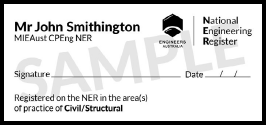Tips for Successful National Engineer Register by WritingAhead

Strong 8k brings an ultra-HD IPTV experience to your living room and your pocket.
Securing a place on Engineers Australia's National Engineering Register (NER) is a significant milestone for engineering professionals in Australia. It not only validates your expertise but also enhances your professional credibility. Drawing insights from the experts at WritingAhead, here are essential tips to guide you through a successful NER application.
If you're aiming to secure a spot on Australia's National Engineering Register (NER), following a structured approach is crucial. WritingAhead offers expert guidance to help engineers craft compelling applications that meet Engineers Australia's stringent standards. Here's a comprehensive guide to ensure your application stands out:
1. Understand the NER Competency Requirements
Before initiating your application, familiarize yourself with the core competencies assessed by Engineers Australia:
- Personal Commitment: Demonstrating dedication to ethical practices and continuous professional development.
- Obligation to Community: Ensuring public safety and environmental sustainability in engineering practices.
- Value in the Workplace: Contributing effectively to organizational goals and mentoring junior engineers.
- Technical Proficiency: Applying engineering knowledge to solve complex problems.
A thorough understanding of these competencies will help tailor your application to meet the specific criteria.
2. Crafting a Structured Work Experience Statement
Your Work Experience Statement should be concise (max 700 words per project) and highlight your engineering expertise. A well-structured statement typically includes:
- Introduction: Provide an overview of the project and your specific role.
- Technical Responsibilities & Challenges: Detail the engineering tasks you undertook and the challenges faced.
- Problem-Solving Techniques: Explain the methods and strategies you employed to overcome obstacles.
- Tools & Standards Used: Mention any engineering tools, software, or standards (e.g., AS/NZS, ISO) you utilized.
- Outcomes & Achievements: Highlight the results of your work, emphasizing quantifiable achievements.
- Use bullet points and professional formatting to enhance readability.
3. Demonstrating Core Competencies
Engineers Australia assesses applicants based on specific competencies. Ensure your application addresses the following:
- Technical Expertise & Problem-Solving: Showcase your ability to apply engineering principles effectively.
- Project Management & Risk Mitigation: Demonstrate your skills in managing projects and addressing potential risks.
- Compliance with Standards: Illustrate your adherence to Australian engineering standards and regulations.
- Ethical & Sustainable Practices: Provide examples of ethical decision-making and commitment to sustainability.
- Use specific project examples to illustrate these competencies.
4. Craft a Detailed Work Experience Statement (WES)
Your WES should provide a comprehensive overview of your engineering experience:
- Chronological Order: List your roles starting from the most recent, detailing responsibilities and achievements.
- Project Highlights: Describe significant projects you've undertaken, emphasizing your role and the outcomes.
- Technical Details: Include specific engineering methods, tools, and standards applied.
- Ensure that your WES aligns with the competencies required for NER registration.
5. Highlight Continuous Professional Development (CPD)
Demonstrate your commitment to lifelong learning by detailing CPD activities:
- Courses and Workshops: Mention relevant training sessions attended.
- Certifications: List any additional qualifications acquired.
- Professional Engagements: Include participation in seminars, conferences, or professional bodies.
- This showcases your dedication to staying updated with industry advancements.
6. Securing Strong Referee Reports
- Referees play a pivotal role in validating your experience. To obtain impactful references:
- Choose Appropriate Referees: Select professionals familiar with your work, preferably supervisors or project managers.
- Provide Clear Guidelines: Inform them about the competencies they need to address.
- Ensure Detailed Feedback: Encourage them to elaborate on your contributions and strengths.
- Referee reports should be signed, dated, and include the referee’s position and contact details.
7. Provide Strong Referee Statements
Select referees who can vouch for your engineering competencies:
- Professional Relationship: Preferably supervisors or senior colleagues familiar with your work.
- Detailed Testimonials: Referees should provide specific examples of your engineering capabilities.
- Contact Information: Ensure accurate and up-to-date contact details are provided.
- Strong referee statements add credibility to your application.
8. Adopting a Professional Writing Approach
Your application should reflect professionalism and clarity:
- Structured Format: Organize content with clear headings and logical flow.
- Active Voice: Use first-person narratives to describe your experiences.
- Quantify Achievements: Support statements with data and measurable outcomes.
- Avoid Plagiarism: Ensure originality by writing in your own words and using plagiarism-checking tools.
- Proofread your application thoroughly and consider seeking feedback from peers or mentors.
9. Prepare for the NER Interview
Some applicants may be required to attend an interview:
- Review Your Application: Be well-versed with the details provided in your submission.
- Anticipate Questions: Prepare to discuss your experiences, challenges faced, and problem-solving approaches.
- Professional Demeanor: Exhibit confidence, clarity, and professionalism during the interview.
- Preparation is key to articulating your competencies effectively.
6. Seek Professional Assistance
Engaging with experts like WritingAhead can enhance the quality of your application:
- Expert Review: Receive feedback on your WES and CPD records.
- Guidance: Understand the nuances of the NER application process.
- Document Preparation: Ensure all submissions meet Engineers Australia's standards.
- Professional assistance can streamline the application process and improve your chances of success.
Conclusion
Achieving registration on the National Engineering Register is a testament to your engineering proficiency and commitment to the profession. By understanding the competency requirements, meticulously preparing your documentation, and seeking expert guidance, you can navigate the application process with confidence. Remember, this recognition not only validates your skills but also opens doors to advanced career opportunities in the engineering sector.
Note: IndiBlogHub features both user-submitted and editorial content. We do not verify third-party contributions. Read our Disclaimer and Privacy Policyfor details.




